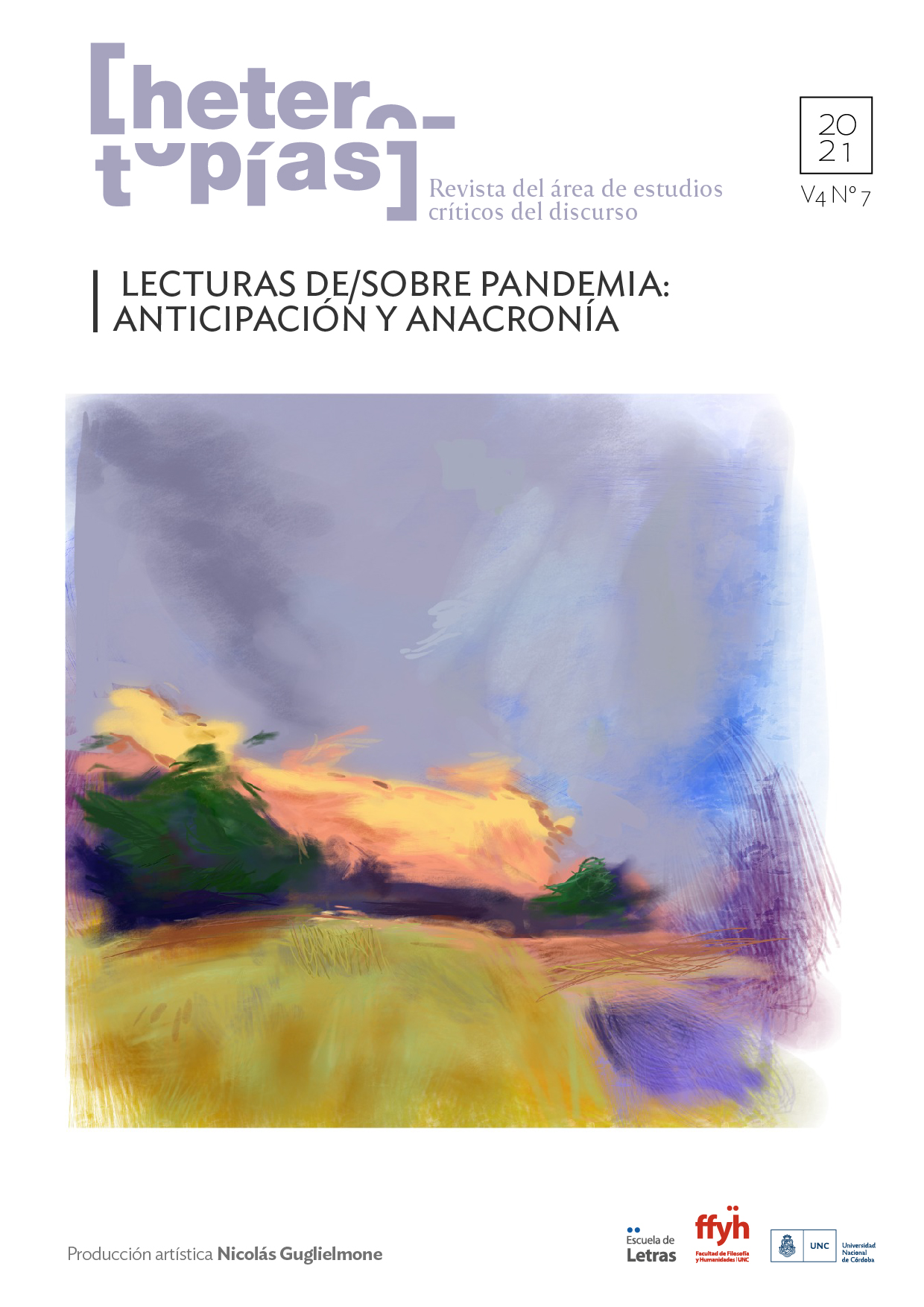"Readings from/about pandemics. Anticipation and anachrony".
Main Article Content
Abstract
The archive of pandemic dreams, which points to the recurrence of the person and the house, shifts from the mythology of the individual and trauma to allow itself to be traversed by otherness. It is a cartography inhabited by multiplicities and without the stratification of wakefulness. Less as metaphor and more as constatation, the universe of dreams recycles materials taken from the visual imagination and the stories of and about the pandemic.
Downloads
Article Details

This work is licensed under a Creative Commons Attribution-NonCommercial-ShareAlike 4.0 International License.
Those authors who have publications with this journal, accept the following terms: Those authors who have publications with this journal, accept the following terms:
a. The authors will keep their copyright and guarantee to the journal the right of first publication of their work, which will be simultaneously subject to the Creative Commons Attribution - Non-Commercial - Share Alike (by-nc-sa) Attribution License; no commercial use of the original work or any derivative works is allowed, the distribution of which must be done with a license equal to the one that regulates the original work.
b. Authors may adopt other non-exclusive license agreements for the distribution of the published version of the work (e.g., deposit it in an institutional telematic archive or publish it in a monographic volume) provided that the initial publication in this journal is indicated.
c. Authors are allowed and recommended to disseminate their work through the Internet (e.g. in institutional telematic archives or on their website) before and during the submission process, which may lead to interesting exchanges and increase the number of citations of the published work. (See The effect of open access).
How to Cite
References
Agamben, G. (2009). “What Is the Contemporary?”. What Is an Apparatus? and Other Essays. Stanford: Stanford University Press.
-------- (2020). “La invención de una epidemia”. En P. Amadeo (Ed.), Sopa de Wuhan. Pensamiento político en tiempos de pandemia (pp. 17-19). Buenos Aires: ASPO, 2020. Publicado originalmente en Quodlibet.it, 26 de febrero de 2020.
Berardi, F. (2020). El umbral. Crónicas y meditaciones. Buenos Aires: Tinta Limón.
Charbonneau, H., Luciani, M.A. (productores) y Robin Campillo (director). (2017). 120 battements par minute / 120 pulsaciones por minuto [Cinta cinematográfica]. Francia: Memento Films.
Dillon, M. (2004). Vivir con virus. Relatos de la vida cotidiana. Buenos Aires: Norma.
Giorgi, G. y Kiffer, A. (2020). Las vueltas del odio: gestos, escrituras y políticas. Buenos Aires: Eterna cadencia.
Han, Byung-Chul (2020). “La emergencia viral y el mundo del mañana”. En P. Amadeo (Ed.), Sopa de Wuhan. Pensamiento político en tiempos de pandemia (pp. 97-111). Buenos Aires: ASPO, 2020. Publicado originalmente en El País, 22 de marzo de 2020.
Lemebel, Pedro (1996) Crónicas de sidario. Barcelona: Anagrama.
Perlongher, Néstor (1988) El fantasma del sida. Buenos Aires: Puntosur editores.
Trabucco Zerán, Alia (2020) Me olvido de todo menos de mi cuerpo en Anfibia. Revista digital de la Universidad de San Martín. Buenos Aires. Recuperado de http://revistaanfibia.com/cronica/me-olvido-de-todo-menos-de-mi-cuerpo/?fbclid=IwAR0JIy18gL80-8p-Uot5O-lcXe1XfRrfaawgFgaUhnkP7CF2IBiRECvFch8
Sontag, Susan (1989) El sida y sus metáforas. Barcelona: Muchnik editores.
Zizek, S. (2020). “El coronavirus es un golpe al capitalismo al estilo Kill Bill y podría conducir a la reinvención del comunismo”. En P. Amadeo (Ed.), Sopa de Wuhan. Pensamiento político en tiempos de pandemia (pp. 21-28). Buenos Aires: ASPO, 2020. Publicado originalmente en Russia Today, 27 de febrero de 2020.
